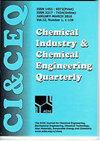用碱性(KOH和NaOH)活化膨润土净化亚齐帖木儿地区的食盐
IF 0.8
4区 工程技术
Q4 CHEMISTRY, APPLIED
Chemical Industry & Chemical Engineering Quarterly
Pub Date : 2023-01-01
DOI:10.2298/ciceq220922008w
引用次数: 0
摘要
开发了多种净化方法,提高了局部盐的质量,NaCl含量达94%。膨润土是提纯杂质时用作粘结剂的材料之一。本研究的目的是用碱溶液合成改性膨润土,碱溶液包括不同浓度(1、1.5、2和2.5 M)的氢氧化钠(NaOH)和氢氧化钾(KOH),并用原子吸收光谱法测定Na+、Ca2+和Mg2+金属的含量。膨润土与活化剂1m(1:10)搅拌3小时。然后,将膨润土在110℃的烤箱中干燥两小时。将活化的膨润土在170℃下干燥4小时。采用XRD、FTIR、SEM等分析技术对活化膨润土进行了表征。衍射图上膨润土的基底间距d001明显不受碱性活化的影响。FTIR分析表明-OH的拉伸振动向较低的波数偏移。碱性活化降低了膨润土中的杂质,增加了孔隙表面的孔隙率。人的食盐经碱性活化后,盐的NaCl含量增加。Na+水平升高后,Ca2+和Mg2+金属含量降低。氢氧化钾活化膨润土的NaCl浓度高于氢氧化钠活化膨润土。本文章由计算机程序翻译,如有差异,请以英文原文为准。
Purification local salt in Aceh Timur regency using alkaline (KOH and NaOH) activated bentonite
The various purification methods have been developed to improve the quality local salt, the NaCl content > 94%. Bentonite is one of materials used as binder impurities in purification. The purpose of the study was to synthesis a modified bentonite using alkaline solution, which includes natrium hydroxide (NaOH) and potassium hydroxide (KOH) with various concentrations (1, 1.5, 2, and 2.5 M) and determined level of Na+, Ca2+ and Mg2+ metals using AAS. The bentonite and activating agent 1 M (1:10) were stirred for three hours. Then, the bentonite was dried for two hours in an oven at 110?C. The activated bentonite was dried for four hours at 170?C. The activated bentonite was characterized using analytical techniques, such as XRD, FTIR, and SEM. The basal spacing d001 on the diffractogram bentonite was significantly unaffected by alkaline activation. FTIR analysis represents the stretching vibration of -OH shifts towards a lower wavenumber. Alkaline activation reduced impurities from bentonite and increase the pore surface's porosity. NaCl levels in people's salt increased after being activated using alkaline. The increase in Na+ levels was followed by decrease content of Ca2+ and Mg2+ metals. KOH-activated bentonite had a higher NaCl level than NaOH-activated bentonite.
求助全文
通过发布文献求助,成功后即可免费获取论文全文。
去求助
来源期刊

Chemical Industry & Chemical Engineering Quarterly
CHEMISTRY, APPLIED-ENGINEERING, CHEMICAL
CiteScore
2.10
自引率
0.00%
发文量
24
审稿时长
3.3 months
期刊介绍:
The Journal invites contributions to the following two main areas:
• Applied Chemistry dealing with the application of basic chemical sciences to industry
• Chemical Engineering dealing with the chemical and biochemical conversion of raw materials into different products as well as the design and operation of plants and equipment.
The Journal welcomes contributions focused on:
Chemical and Biochemical Engineering [...]
Process Systems Engineering[...]
Environmental Chemical and Process Engineering[...]
Materials Synthesis and Processing[...]
Food and Bioproducts Processing[...]
Process Technology[...]
 求助内容:
求助内容: 应助结果提醒方式:
应助结果提醒方式:


